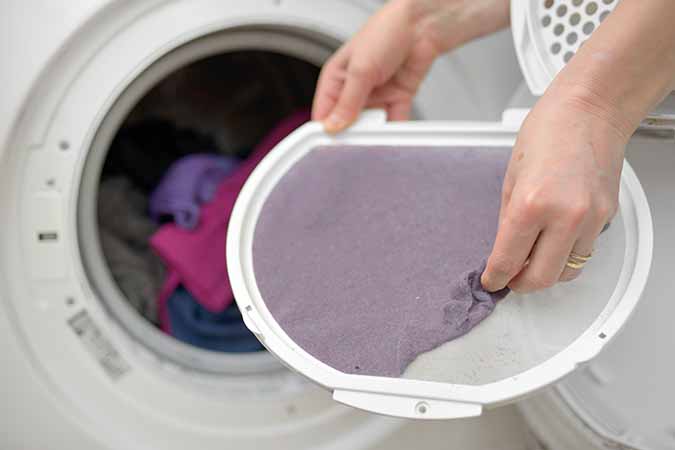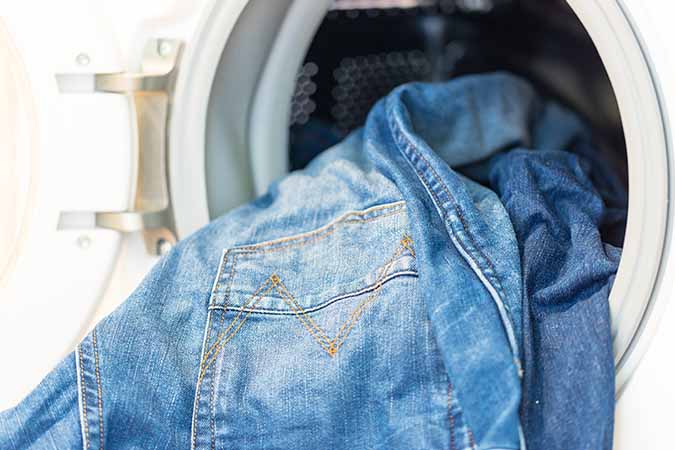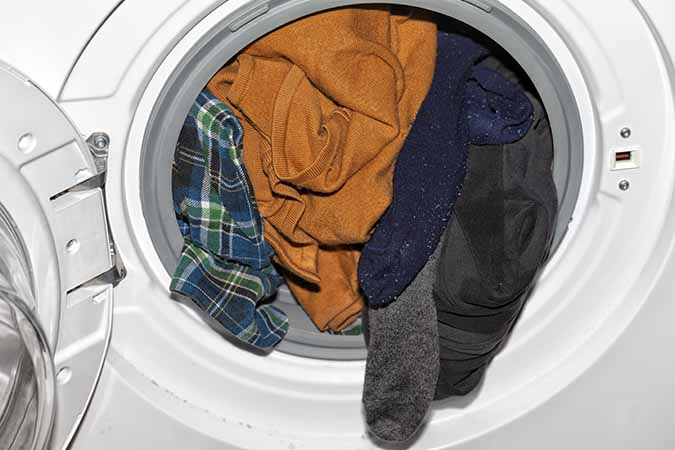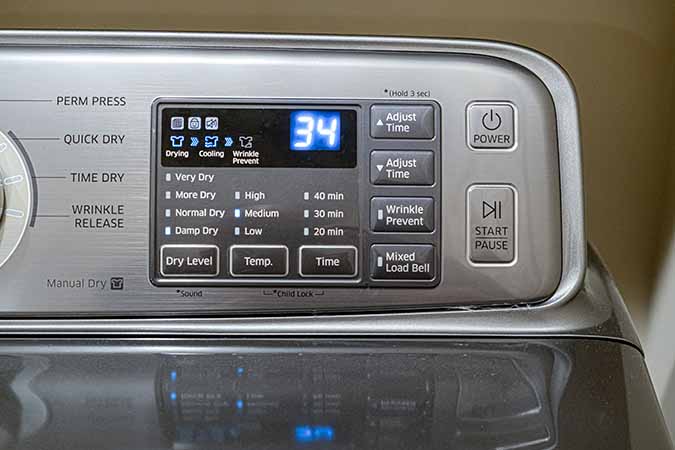Overusing or Underusing Laundry Detergent

When laundry begins to pile up, many believe it’s best to toss all garments into the washing machine and douse them in laundry detergent. Unfortunately, using an excessive amount of detergent isn’t the answer. This actually can create more problems. The extra suds prevent a thorough wash by holding onto dirt and grime.
And because you can use too much laundry detergent, you can also use too little. Underusing detergent can leave clothes as dirty as they were before being washed. This is why it’s so important to follow directions on clothing labels and laundry detergent bottles. Using the appropriate amount of detergent will ensure that clothes are cleaned properly.
Throwing All Garments into the Dryer

One of the most common laundry mistakes is to transfer all garments from the washer to the dryer. Although it may seem like the easiest thing to do, we don’t recommend it. This is why it’s crucial that you read clothing labels and laundering instructions. The last thing you want to do is ruin your clothes—and know that it could’ve been prevented.
Hanging clothes to dry takes a little extra time, but is so worth it. Delicate garments, like activewear, underwear, and jeans, are easily damaged by heat. To avoid heat damage, allow these delicate fabrics to air dry. As a rule of thumb, we recommend hanging garments that are made of wool, lace, or synthetics.
Sorting Clothes Incorrectly

There are many rules to follow when it comes to laundry. One of the more well-known rules is to sort clothes by color. I’m sure you’ve been told countless times that “light-colored garments wash separately from dark-colored garments.” Clothing should be separated in this way so dark colors don’t bleed onto light-colored clothing items.
Sorting clothes by color prevents accidents, but sorting clothes by fabric aids cleaning. The simplest way to sort by fabric is to separate laundry into groups—denim, woolens, performance fabrics, delicates, and everyday laundry. After clothes are sorted by fabric, they can then be sorted by color and laundered. This will ensure that your clothes are cleaned efficiently and correctly.
Neglecting the Lint Filter

Every clothes dryer has a lint filter. And contrary to popular belief, these lint filters should not be overlooked. Dryers are equipped with them for a reason. As clothes dry, lint collects. The majority of lint filters are located in a convenient spot so they’re easily accessible.
It’s so important to clean your lint filter after every clothing cycle because lint collects quickly. If you neglect your lint filter, not only will your dryer have to work harder to dry your clothes, but you’ll be creating a fire risk. Clogged lint filters pose a fire hazard and can become a much bigger problem.
Ignoring Laundry Symbols

As tedious as it may be, checking clothing labels for washing instructions is necessary. This will increase the longevity of your garments. By paying attention to these instructions, you will know exactly how to wash and dry your clothes. Gone are the days of shrunken or misshapen clothing pieces.
If you aren’t sure how to read laundry symbols, there are hundreds of guides online that explain each and every symbol. Once you find one that works for you, print it off and hang it in your laundry room so you can reference it as needed. Eventually, you’ll know these symbols by memory!
Wasting Time Between Cycles

In hopes to save you time, we’re debunking one of the most common laundry myths. Have you ever finished a load of laundry and thought about starting another load—but hesitated? If you have, we have news for you!
Your clothes washer and dryer do not need time to “cool off” between cycles. This is a myth that many abide by. But because it’s not true, you can stop wasting time. Instead of waiting between cycles, just clean the lint filter on the dryer and keep laundering. Clothes washers and dryers are designed for use.
Overdrying Clothes

Many people are guilty of overdrying their clothes (ourselves included). Once you’ve thrown your garments into the dryer, you set it for longer than you should, knowing well and good that your clothes never actually take that long to thoroughly dry.
And once the dryer stops, you may even restart it for another 10 to 20 minutes because you’re just not ready to fold your clothes just yet. While this seems harmless, allowing clothes to dry longer than necessary can be damaging. Fabrics often show signs of additional wear when overdried. Because of this, clothes that are still a little damp after being dried shouldn’t be zapped again in the dryer. Instead, let these garments finish air-drying on a drying rack.
Leaving Jackets and Jeans Unzipped

Clothing can be severely damaged if not laundered correctly. And while the culprit is usually the clothes washer or dryer, it can also be other garments. When washing jackets and jeans, make sure zippers are completely zipped. If they’re not, you’re succumbing your clothing to potential damage.
This is because loose zippers can snag delicate clothing items. Lace, wool, and synthetic materials are at risk. These are fabrics that are easily snagged by the metal teeth of undone zippers. To prevent ripping and tearing, always check that items with zippers are zipped all the way up before throwing them in the wash with delicates.
Scrubbing Stains

Frantically scrubbing red wine stains or other dark and dangerous stains can be fatal. You may think scrubbing these stains will eliminate the problem, but it won’t. The next time you spill something on your favorite white garment, resist the urge to scrub—it may save it.
Because over-scrubbing stains often creates wear and tear on fabric and spreads the stain, we don’t recommend it. Instead, gently dab the stain with a clean cloth and stain remover. Then, throw the garment into the wash ASAP. The quicker you get the item into the washing machine, the better. The last thing you want is for a stain to set in!
Never Cleaning Washing Machine

Laundry is a chore in itself, so hearing that you also need to clean your washing machine periodically is downright devastating. No one wants to add something else to their endless to-do list. But, it’s necessary. Unlike clothes dryers, washing machines are constantly filled with water, residue, minerals, and chemicals.
Luckily, there are several tips and tricks to help you keep your washing machine clean! Clean the detergent drawer and door seal on a regular basis to prevent molding, run a service wash once or twice a month in order to eliminate unwanted bacteria, and keep the washer door open when not in use.
Unnecessarily Splurging on Laundry Detergent

Contrary to popular belief, you don’t have to splurge on pricey laundry detergent to get your clothes clean. As long as you use something measurable to Tide or Persil, you should be fine.
These two brands are front-runners because they perform well. Although they’re not a steal, they’re cheaper than the extremely expensive detergents that celebrities swear by. Both Tide and Persil offer liquid detergents that are able to remove dirt, grime, and stains. And luckily, a little laundry detergent goes a long way—meaning a bottle of detergent should last a while if you’re not overusing!
Rewearing Instead of Washing

One of the more prominent laundry mistakes that many people make is rewearing clothing items multiple times before washing. While there are some garments that re-wear well (like denim), the majority of garments should only be worn once.
Wearing clothing items multiple times before washing may decrease the amount of laundry you have to wash and dry, but it may not be the most sanitary option. This is because clothing items often collect dirt and sweat while being worn. This is inevitable. Even if you’re super clean, you still shed dead hair and skin cells. So, washing items that are even questionably dirty is probably a good idea.
Overfilling Washer and Dryer

If you’ve ever stuffed your washer with all of the clothes in your laundry basket in order to avoid multiple loads and an entire afternoon of laundry…you’re not alone. Although washing everything at once may seem efficient, it’s actually the opposite.
Overfilling your washer and dryer is counterproductive. If there are too many clothing items in the washer, they’re not going to get cleaned thoroughly. And if there are too many items in the dryer, they won’t dry completely. Instead, separate your garments by color and fabric and accept the fact that you’ll have to do more than one load of laundry.
Not Using Fabric Softener

Using fabric softener is actually encouraged—the trick is just knowing what garments to use it on. It’s known for softening fibers, meaning it has the ability to reduce wrinkles, eliminate static cling, and make laundry smell fragrant.
There are lots of pros to using fabric softener—except on flame-resistant or water-repellant fabric, clothing made of microfiber, sportswear, or towels. These are all items that negatively react to the softening of fibers!
Ignoring Dryer Settings

Dryers typically have a number of knobs that indicate different heat settings and care cycles. The mistake that people make is ignoring these knobs. Different garments require different dryer settings. Always drying clothes on the same heat setting and care cycle can be damaging.
This mistake normally happens out of sheer laziness. Instead of separating clothes by color and fabric and paying attention to clothing labels and laundry symbols, people toss all of their damp clothes into the dryer and turn it on. Paying attention to dryer settings can increase the longevity of clothing and keep garments looking new.
 Author
Jennifer Freehill
Last Updated: August 29, 2025
Author
Jennifer Freehill
Last Updated: August 29, 2025